
views
X
Trustworthy Source
Cleveland Clinic
Educational website from one of the world's leading hospitals
Go to source
Less commonly, a toe can be crushed such that the bones are completely shattered (a comminuted fracture) or fractured such that the bones radically misalign and stick out through the skin (an open compound fracture). Understanding the severity of your toe injury is crucial because it determines the type of treatment protocols you should follow.
Getting Diagnosed
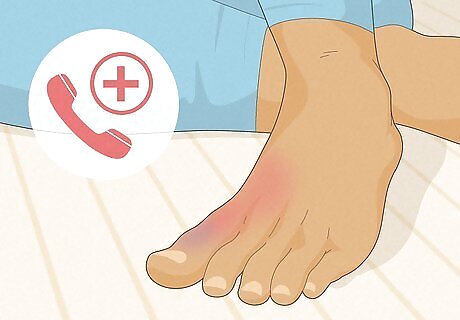
Schedule an appointment with your doctor. If you develop sudden toe pain from some type of trauma and it doesn't fade away after a few days, then schedule an appointment with your family physician or go to the emergency room of your local hospital or an urgent care clinic that has X-ray services if symptoms are severe. Your doctor will examine your toe and foot, ask questions about how you injured it, and maybe even take X-rays in order to determine the extent of the injury and type of fracture. However, your family doctor is not a musculoskeletal specialist, so you may need a referral to another doctor with more specialized training for serious problems with your toe. The most common symptoms of a broken toe include intense pain, swelling, stiffness and usually bruising due to some internal bleeding. Walking is difficult, and running or jumping nearly impossible without excruciating pain. Other types of healthcare professionals who could help diagnose and/or treat broken toes include osteopaths, podiatrists, chiropractors and physiotherapists, as well as emergency room or urgent care physicians.
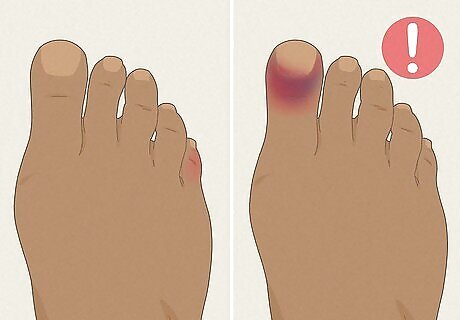
See a specialist. Small hairline (stress) fractures, bone chips and contusions are not considered serious medical conditions, but severely crushed toes or displaced compound fractures often require surgical intervention, especially if the big toe is involved. Medical specialists such as an orthopedist (bone and joint specialist) or physiatrist (muscle and bone specialist) can better assess the seriousness of your fracture and recommend appropriate treatment. Broken toes can sometimes be related to diseases and conditions that affect and weaken bone, such as bone cancer, bone infections, osteoporosis or complications related to diabetes, so the medical specialists need to consider these when examining your toe. X-rays, bone scans, MRI, CT scan and ultrasound are modalities that specialists may use to help diagnose your broken toe. Broken toes are usually the result of dropping something heavy on the foot or "stubbing" a toe against something hard and immovable.

Understand the type of fracture and most appropriate treatments. Make sure you get the doctor to clearly explain the diagnosis (including the type of fracture) and provide you with various treatment options for your injury, as simple stress fractures can usually be treated at home. In contrast, a mangled, bent, or deformed toe is usually a sign of a more serious fracture and best left to trained professionals. The smallest toe (5th) and the biggest (1st) are fractured more often than the other toes. Joint dislocations can cause crooked toes also and look similar to fractures, but physical examination and X-rays will distinguish between the two conditions.
Treating Stress and Non-Displaced Fractures
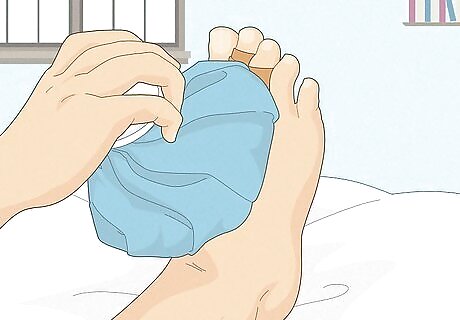
Utilize the R.I.C.E. treatment protocol. The most effective treatment protocol for minor musculoskeletal injuries (including stress fractures) is abbreviated R.I.C.E. and stands for rest, ice, compression and elevation. The first step is rest — temporarily stop all activity that involves your injured foot in order to address your injury. Next, cold therapy (ice wrapped in a thin towel or frozen gel packs) should be applied to the broken toe as soon as possible in order to stop any internal bleeding and reduce inflammation, preferably while your leg is elevated on a chair or stack of pillows (which also combats inflammation). Ice should be applied for 10-15 minutes every hour, then reduce the frequency as the pain and swelling subside over the course of a few days. Compressing the ice against your foot with a compression bandage or elastic support will also help control the inflammation. Don't tie the compression bandage too tight or leave it on for more than 15 minutes at a time because complete restriction of blood flow could cause more damage to your foot. Most uncomplicated broken toes heal well, usually within four to six weeks, at which time you can slowly resume athletic activities.
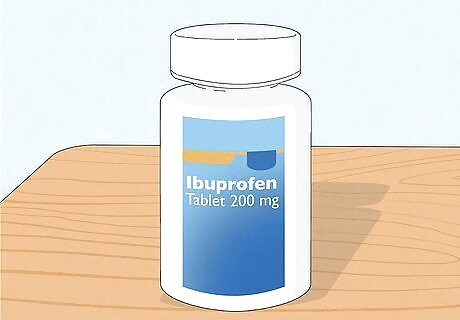
Take over-the-counter medications. Your doctor may recommend anti-inflammatories such as ibuprofen, naproxen or aspirin, or regular analgesics (painkillers) such as acetaminophen to help combat the inflammation and pain associated with your toe injury. These medications tend to be hard on your stomach, liver and kidneys, so they shouldn't be taken for more than two weeks at a time.

Tape your toes for support. Tape your broken toe to an adjacent uninjured toe (called buddy taping) for support and to assist realigning it if it's somewhat crooked (speak with your doctor first if your toe appears crooked). Thoroughly clean your toes and feet with alcohol wipes and then use strong medical-grade tape that's preferably waterproof so it can withstand showering. Change the tape every few days over the course of a few weeks. Consider putting some gauze or felt in between your toes before taping them together in order to prevent skin irritation. To make a simple, homemade splint for additional support, place trimmed Popsicle sticks on both sides of your toes before taping them together. If you're unable to tape your own toes, then ask your family doctor, specialist, chiropractor, podiatrist or physical therapist for assistance.
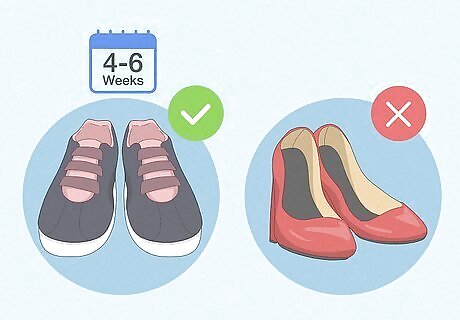
Wear comfortable shoes for four to six weeks. Immediately after your toe injury, switch to comfortable-fitting shoes that have plenty of room in the toe cap in order to accommodate the swelling and the taping. Choose hard-soled, supportive and sturdy shoes over more trendy types and avoid wearing high heels for at least a few months, because they push your weight forward and severely crowd the toes. Supportive open-toed sandals may be used if the inflammation is excessive, but remember that they don't offer any toe protection.
Treating Displaced or Open Compound Fractures

Get reduction surgery. If the broken bone fragments don't align together, the orthopedic surgeon will manipulate the pieces back into normal position — a process called reduction. In some cases, reduction can be accomplished without invasive surgery depending on the number and positioning of the bone fragments. A local anesthetic is injected into the toe to numb the pain. If the skin is broken due to the trauma, stitches will be needed to close the wound and topical antiseptics administered. With open fractures, time is of the essence because of potential blood loss and the risk of infection or necrosis (local tissue death due to lack of oxygen). Strong painkillers such as narcotics may be prescribed until anesthesia is administered in the operating room. Sometimes with severe fractures, pins or screws may be required to hold the bones in place while they heal. Reduction isn’t just used with open compound fractures; it is also used with any fracture with significant displacement.

Wear a splint. After a reduction of your broken toe, a splint is often put in place to support and protect the toe while it heals properly. Alternatively, you may have to wear a supportive compression boot, but either way, you'll likely need the use of crutches over the short term (two weeks or so). At this stage, minimizing walking and resting with your injured foot elevated is still highly recommended. Although splints provide support and cushioning, they don't provide much protection, so be extra careful not to bump your toe while walking. During the bone-healing phase, make sure your diet is rich in minerals, especially calcium, magnesium and boron, as well as vitamin D in order to promote bone strength.
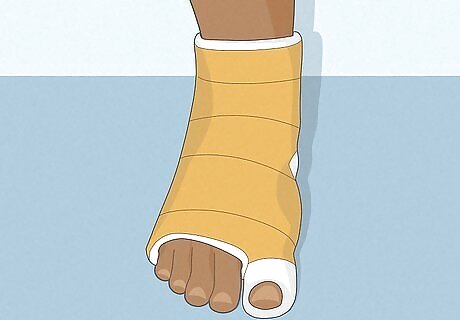
Get a cast. If more than one toe is broken or other bones of the forefoot are injured (such as the metatarsals), then your doctor might apply a plaster or fiberglass cast to your entire foot. Short-leg walking casts are also recommended if the fragments won't stay snugly together. Most broken bones heal successfully once they have been repositioned and are protected from further trauma or excessive pressure. Following surgery, and especially with the help of a cast, severely broken toes take six to eight weeks to heal, depending on the location and extent of the injury. After such a long time in a cast, your foot may need some rehabilitation as described below. After a week or two, your doctor may request another set of X-rays to ensure that the bones are aligned and healing properly.
Dealing With Complications

Watch for signs of infection. If the skin is broken near your injured toe, you are at higher risk of developing an infection within the bone or the surrounding tissues. Infections get swollen, red, warm and very tender to the touch. Sometimes they leak pus (which represents your white blood cells at work) and smell bad. If you experienced an open compound fracture, your doctor may recommend a precautionary two-week course of oral antibiotics to deter the growth and spread of bacteria. Your doctor will examine the area carefully and prescribe antibiotics if there is an infection. Your doctor may recommend a tetanus shot following a serious fracture if it was caused by puncturing or lacerating your skin.
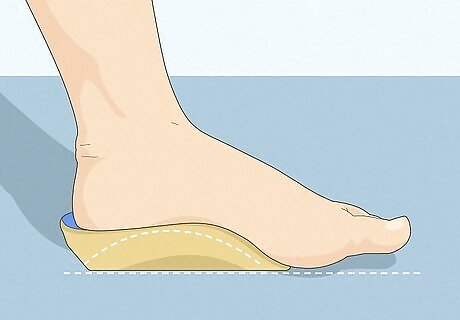
Wear shoe orthotics. Orthotics are customized shoe inserts that support the arch of your foot and promote better biomechanics while walking and running. Following a broken toe, especially if the big toe is involved, your gait and foot biomechanics may be negatively altered from limping and avoiding toeing off. Orthotics will help reduce the risk of problems developing in other joints such as the ankle, knee and hips. With a severe fracture, there's always a risk of arthritis developing in surrounding joints, but orthotics can mitigate the risk.
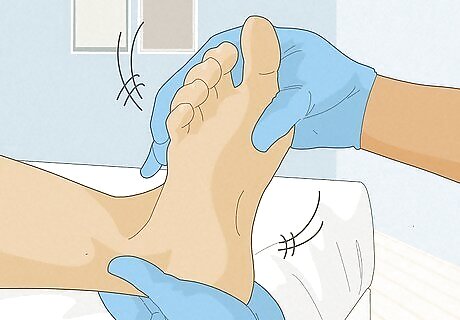
Seek out physical therapy. After the pain and inflammation have disappeared and the broken bone is healed, you may notice the range of motion or strength within your foot is reduced. As such, ask your doctor for a referral to a sports medicine specialist or physiotherapist who can offer a variety of tailored strengthening exercises, stretches and therapies in order to improve your range of motion, balance, coordination and strength. Other health professionals that may be able to help rehabilitate your toe/foot include podiatrists, osteopaths and chiropractors.



















Comments
0 comment